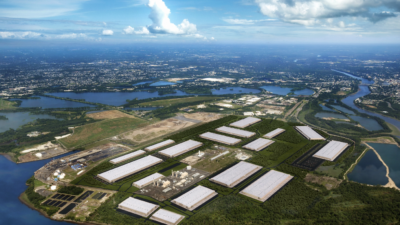The 2024 National Industrial Conference brought together industry leaders and industrial real estate professionals to discuss the current market landscape and the industrial sector trends. This year’s discussions focused on occupier strategies, demand in niche industrial sectors, global influences, and investment opportunities that are set to impact the industry in the coming years.
Navigating a Shifting Market: Occupier Perspectives
The industrial occupier panel provided insights into how tenants are adapting to the industrial landscape marked by high rental rates. Katie Matthews of TricorBraun expressed concerns about ongoing “sticker shock” from elevated rental costs in major markets. While the situation is improving, the overall market is still far from reaching a comfortable equilibrium for some tenants. However, Christopher Zangrilli from SCHENKER Americas Inc. shared that he has seen a shift in the leverage dynamic between landlords and tenants, noting that landlords are increasingly willing to offer concessions like tenant improvement dollars and shorter lease terms. This flexibility has allowed tenants to secure shorter commitments, such as three-year leases, which were previously harder to negotiate. Amanda Sevilla of Expeditors emphasized the importance of her firm’s strategy in remaining “asset-light” and aligning lease terms with operational efficiency and long-term strategy. She also shared that for Expeditors, sustainability is at the forefront, so they take advantage of advancements like LED motion sensor lighting and battery-operated forklifts when possible.
Industrial Research: Regional Disparities and Investor Outlook
Colliers’ Craig Hurvitz stated that the sector has experienced 56 consecutive quarters of positive net absorption since 2010, indicating strong demand. However, since 2023, new supply has consistently outpaced demand, leading to rising vacancy rates in some regions.
Demand levels vary significantly across regions. In the Midwest, demand is at 80% of new supply, while in the West, it’s just 7%, reflecting a stark contrast in market conditions. Meanwhile, the South and Northeast are seeing demand at 30% and 16% of new supply, respectively. Nationally, vacancy rates are expected to peak at 6-7% in early 2025 before stabilizing. Construction trends are also shifting, with the amount of space under development dropping from a high of 710 million square feet in late 2022 to around 360 million square feet by mid-2024.
Aaron Jodka noted that industrial market values are beginning to recover, creating a window of opportunity for investors. With rate cuts of 150 basis points expected by the end of 2025 and a 50% increase in capital markets volume projected in 2025, now is an opportune time for investors to act. Additionally, data centers are emerging as a strong focus for investors (Blackstone estimated that $1 trillion will be invested in data center development in the U.S. over the next five years). This surge will create competition for land, financing, and power, impacting broader industrial real estate dynamics.
Global Perspectives: China’s Industrial Landscape and Opportunities for the U.S.
Colliers’ Tammy Tang shared insights into the changing industrial real estate market in China, which is undergoing a dramatic transformation. While international companies once set up operations in China, the trend has now reversed, with Chinese firms expanding aggressively overseas, to gain advantages from globalization. Aside from e-commerce, sectors that are expanding from China to the U.S. and abroad are automotive, particularly EV and batteries, and clean energy. For example, ten major Chinese megadeals are ongoing in Mexico, and another 4-5 are in progress in the U.S. However, the Chinese industrial market is facing significant challenges. Because of oversupply, current vacancy rates are around 30%, and market rents have dropped between 30% and 50% from peak levels. Despite high investment in automation and drone technology, the market is experiencing an “L”-shaped recovery that has yet to show signs of a rebound.
The Demand for Data Centers, Cold Storage, and IOS
The industrial sector is seeing strong demand in data centers, cold storage, and Industrial Outdoor Storage (IOS). Data center demand is skyrocketing, driven by the rise of AI. Power availability continues to be the primary factor in the site selection process. Cold storage is also growing, as many existing buildings are now functionally obsolete. The average age of existing cold storage assets is 31 years old in the top cold storage markets. Occupiers for temperature-controlled warehouses are increasingly adopting automation, seeking more efficient facilities, and site preferences hinge on proximity to ports and population centers. This sector spans four asset classes—public refrigerated warehouses (PRW), food manufacturing, grocery/e-commerce, and pharma/life sciences—each with unique needs. IOS is facing growing demand from institutional capital, but securing new sites is challenging due to municipal reluctance to rezone, making heavily industrial-zoned land highly attractive. We expect to see continued demand on the occupier and capital side within the IOS sector.
Investor Sentiment: Bullish on Select U.S. Markets
The capital markets panelists expressed a strong focus on top U.S. markets such as Southern California, Chicago, Dallas, South Florida, Eastern Pennsylvania, and New Jersey. These markets are viewed as the most promising for long-term investment due to their robust fundamentals and strategic locations. Developers are also prioritizing credit tenants and assessing local political dynamics, particularly in municipalities facing high levels of NIMBYism (Not In My Backyard) opposition to new developments. Developers are worried about the availability of power, transitioning to a clean energy source, the slowing leasing volume, and the warehouse indirect source rule in Southern California. However, all expressed optimism that industrial is a product type that is expected to outperform other asset classes over the next ten years and drive strong, long-term investment.
Outlook for 2025 and Beyond
As the market looks ahead to 2025, several key trends are expected to shape the industrial landscape:
- Vacancy Rates: Expected to peak in early 2025 and then gradually decline as supply and demand come back into balance.
- Capital Markets Rebound: A 50% increase in transaction volume is anticipated for 2025, driven by improving market conditions.
- Speculative Development Resurgence: New speculative projects are likely to ramp up again as long-term demand drivers remain strong, and the market stabilizes.
The emphasis on data-driven strategies and long-term growth will continue to influence decision-making as the market prepares for the next wave of growth in 2025. Maintaining a proactive approach and leveraging key data points will be crucial for gaining the edge.

 Jake Spinell
Jake Spinell

 Michael Golarz
Michael Golarz Tom Golarz
Tom Golarz
 Craig Hurvitz
Craig Hurvitz
 Lauren Pace
Lauren Pace Ronna Larsen
Ronna Larsen